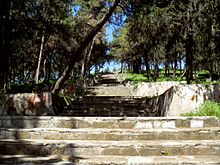Yumuktepe: Difference between revisions
Nedim Ardoğa (talk | contribs) |
Rescuing 1 sources and tagging 0 as dead. #IABot (v1.1) |
||
| Line 60: | Line 60: | ||
== Discovery and excavations == |
== Discovery and excavations == |
||
Excavations during 1936-1938 period by British archaeologist [[John Garstang]] (1876–1956) who is the founder of the British Institute at Ankara,<ref> |
Excavations during 1936-1938 period by British archaeologist [[John Garstang]] (1876–1956) who is the founder of the British Institute at Ankara,<ref>{{cite web|url=http://www.biaa.ac.uk/home/ |title=Archived copy |accessdate=March 26, 2010 |deadurl=yes |archiveurl=http://web.archive.org/web/20100424062514/http://www.biaa.ac.uk:80/home/ |archivedate=April 24, 2010 }}</ref> have revealed a [[neolithic]] settlement which continued up to medieval ages. However, the excavations halted during World War II and some documents in the [[Liverpool University]] have been lost after an air raid.<ref>[http://www.mersin.bel.tr/]</ref> After the war, John Garstang as well as Veli Sevin of [[İstanbul University]] and Isabella Caneva <ref>[http://www.akmedanmed.com/article_en.php?artID=41&catID=9]</ref> of [[Sapienza University of Rome]] continued the excavations.<ref>[http://www.yumuktepe.com/index.php?option=com_content&view=article&id=189:yumuktepe-2006-kazilari-sonuc-raporu-prof-sabella-caneva&catid=88:oence-yumuktepe-vardi&Itemid=100054]</ref> |
||
== Archaeology == |
== Archaeology == |
||
Revision as of 13:13, 21 July 2016
 | |
| Location | Mersin, Turkey |
|---|---|
| Region | Mediterranean Region |
| Type | Settlement |
| History | |
| Periods | Neolithic Age to Byzantine Empire |
Yumuktepe (or Yümüktepe) is a tell (ruin mound) at 36°48′5″N 34°36′14″E / 36.80139°N 34.60389°E within the city borders of Mersin, Turkey. In 1936, the mound was on the outskirts of Mersin, but after a rapid increase of population, the mound was surrounded by the Toroslar municipality of Mersin.
Discovery and excavations
Excavations during 1936-1938 period by British archaeologist John Garstang (1876–1956) who is the founder of the British Institute at Ankara,[1] have revealed a neolithic settlement which continued up to medieval ages. However, the excavations halted during World War II and some documents in the Liverpool University have been lost after an air raid.[2] After the war, John Garstang as well as Veli Sevin of İstanbul University and Isabella Caneva [3] of Sapienza University of Rome continued the excavations.[4]
Archaeology
There are 23 levels of occupation dating from ca 6300 BC. In his book, Prehistoric Mersin, Garstang lists the tools unearthed in the excavations. The earliest tools are made of either stone or ceramic. Both agriculture and animal husbandry (sheep, cattle, goats and pigs) were among the economic activities in Yumuktepe.[5] In the layer which corresponds to roughly 4500 BC, one of the earliest fortifications in human history exists. According to Isabella Caneva, during the chalcolithic age an early copper blast furnace was in use in Yumuktepe. Yumuktepe was probably a coastal settlement, but because of the alluvion carried by the nearby river Müftü, the mound is now 2.5 kilometres (1.6 mi) north of the Mediterranean shore.
Historical era
Yumuktepe was a part of Kizuwatna a vassal kingdom of Hittite Empire. In a document of 1440 BC, a city named Pitura was mentioned. Pitura might be the ancient name of the settlement. It seems, like most Hittite lands, sea people from Europe plundered Yumuktepe in 13th century BC. A second blow was from Assyrian Empire from Upper Mesopotamia. During Roman Empire, Yumuk was a relatively unimportant city named Zephyrium. But Emperor Hadrian (reigned 117-138) renamed the city as Hadrianapolis. During the early Byzantine Empire, the nearby settlement of Soli (10 kilometres (6.2 mi) at the west) flourished and Yumuk was abandoned.
References
- ^ "Archived copy". Archived from the original on April 24, 2010. Retrieved March 26, 2010.
{{cite web}}: Unknown parameter|deadurl=ignored (|url-status=suggested) (help)CS1 maint: archived copy as title (link) - ^ [1]
- ^ [2]
- ^ [3]
- ^ Seton Lloyd: Ancient Turkey (Trans: Ender Verinlioğlu), Tubitak, pg 21

